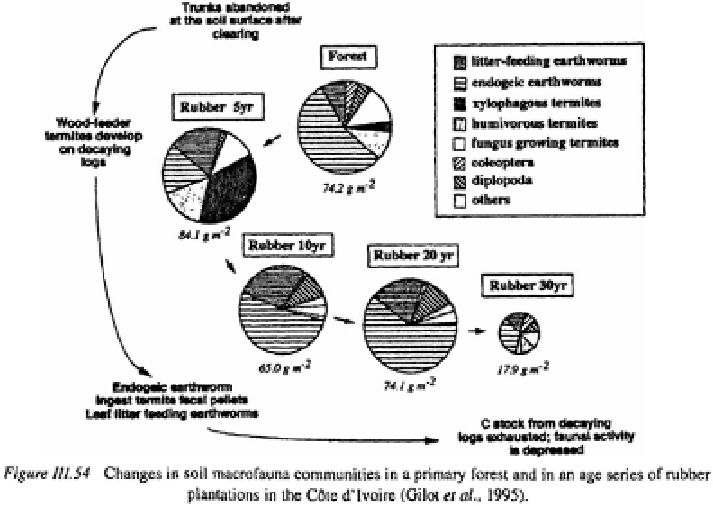Agriculture Reference
In-Depth Information
better than,
e.g.,
litter arthropods or earthworms, although it is largely the species with
deeper subterranean nests that remain (Wood and Pearce, 1991). Consequently, they
often comprise a large proportion of animal biomass in annual crops (Dangerfield, 1990;
Lavelle and Pashanasi, 1989). In five year old
Hevea
plantations in southern Côte
d'lvoire, termite communities comprised more than half of the total
biomass of macroinvertebrate communities. This was due to the development of sub-
stantial populations of wood-feeding termites which utilised the dead woody material
remaining following forest clearance. Ten years later, this woody material had been
exhausted and termite biomass fell to 2.5 five times less than that of the original
forest (Gilot
et al
., 1995) (Figure III.54). However, substantial and damaging populations
may remain in long-cultivated lands and Wood
et al.
(1977) reported economically-
important populations
in 24 year old fields cultivated for groundnuts
(
Arachis hypogaea
).
Fire may depress both the abundance and diversity of termites and alter the balance
of their communities. In Colombian savannas, Decaëns
et al.
(1994) observed a sharp
decrease of termite populations following firing and cattle grazing while earthworm
abundance was enhanced. Abensperg-Traun and Milewski (1995) compared burned and
unburned areas of nine vegetation types in south-western Australia two years after
an intense fire and noted a significantly-reduced incidence of wood-feeding species.
They attributed this to the destruction of colonies nesting in surface wood, rather than
food limitation. Species dwelling in earthen epigeal mounds were noted to be largely
protected from the fire. However, in the northern Australian tropics, small carton-rich
epigeal mounds of
Microcerotermes
sp. are often destroyed by low-intensity annual
fires. Further evidence of shifts in community balances is available. In an African
savanna environment, Benzie (1986) reported a rapid increase in the abundance of the
mounds of grass-harvesting termites in the two years following protection from fire.




